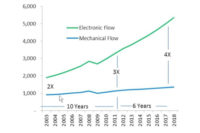TECH FLASH
ARC: WMS market driven by omni-channel requirements
The ARC Advisory Group says the global market for warehouse management systems (WMSs) is driven by macroeconomic growth, demand for add-on modules and the omni-channel retail paradigm shift

The global growth of warehouse management systems (WMSs) is being driven by a return to macroeconomic growth in Europe and a continuing demand for WMS add-on modules, but a new ARC Advisory Group market study says the most influential factor in WMS sales is the shift to omni-channel retailing.
“The growth of e-commerce has amplified fulfillment complexity, presenting WMS suppliers with opportunities to provide retailers with support for this change,” says Clint Reiser, enterprise software analyst and principal author of ARC’s Warehouse Management Systems Global Market Research Study. “Omni-channel retailers are now integrating brick-and-mortar and e-commerce distribution channels in an attempt to streamline costs and develop a holistic and extended view of inventory.”
Omni-channel retailing is a new approach to cross-channel retailing with a focus on strengthening a brand by creating a seamless user and consumer experience across all available platforms and devices.
ARC says WMS suppliers are optimistic about growth prospects. The advisory group adds the return to economic growth should indicate a growth of the WMS market in some European countries.
According to ARC, omni-channel commerce will require a reconfiguration of the ways orders are filled. As brick-and-mortar retailers and manufacturers with direct-to-consumer operations are reconfiguring their fulfillment operations to give more support to multiple channels, these warehouses will require new ways to manage omni-channel waves and shipment documentation.
The addition of e-commerce fulfillment to warehouses has become another place where more functionality modules are needed. To improve inventory accuracy and support in-store fulfillment of e-commerce orders, ARC says many retail stores are adding in-store WMSs.
With the right WMS, large savings can be realized with a reduction in labor. However, ARC notes e-commerce fulfillment will typically increase material handling costs in the warehouse, a development that has heightened a desire to manage warehouse costs and made some upfront productivity investments justifiable.
More information on the study can be found here.
Looking for a reprint of this article?
From high-res PDFs to custom plaques, order your copy today!







